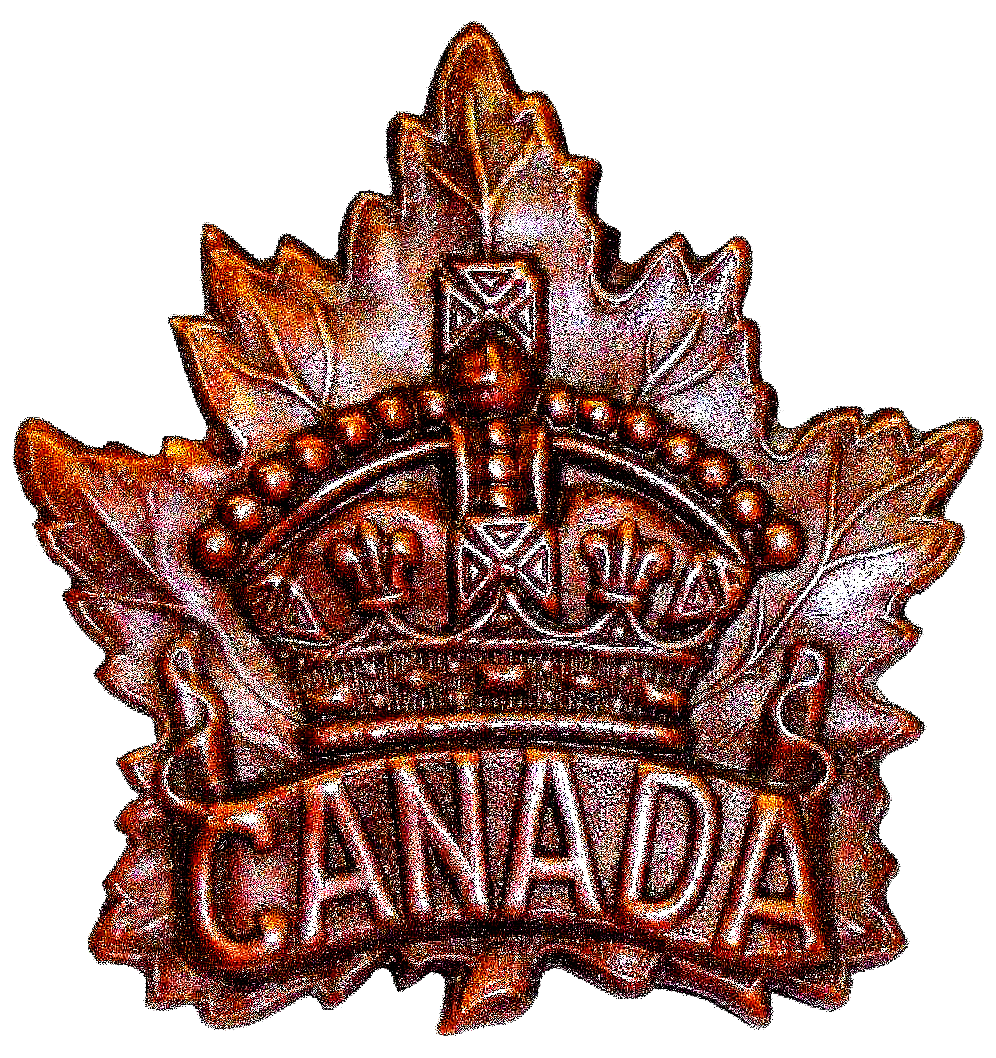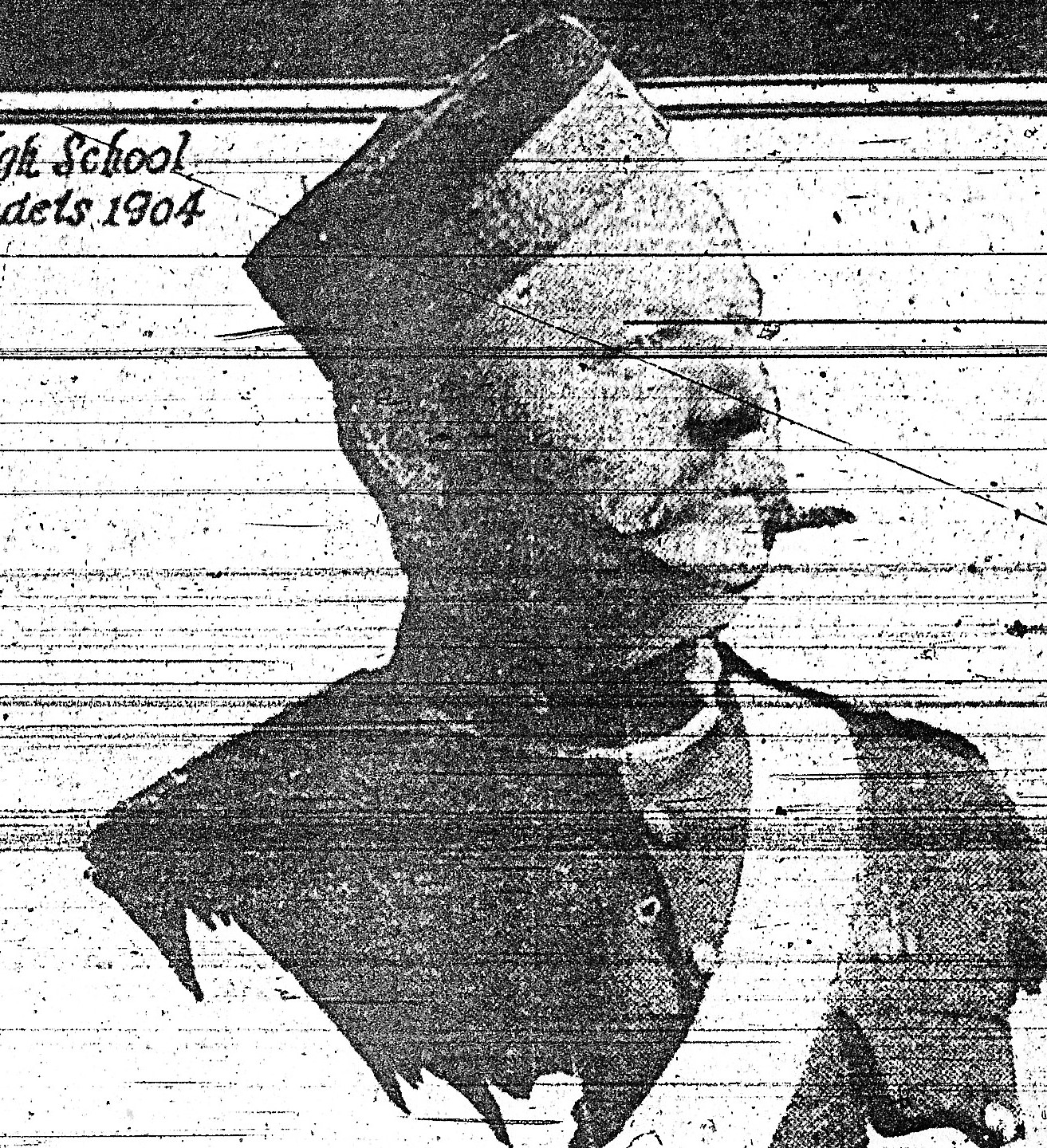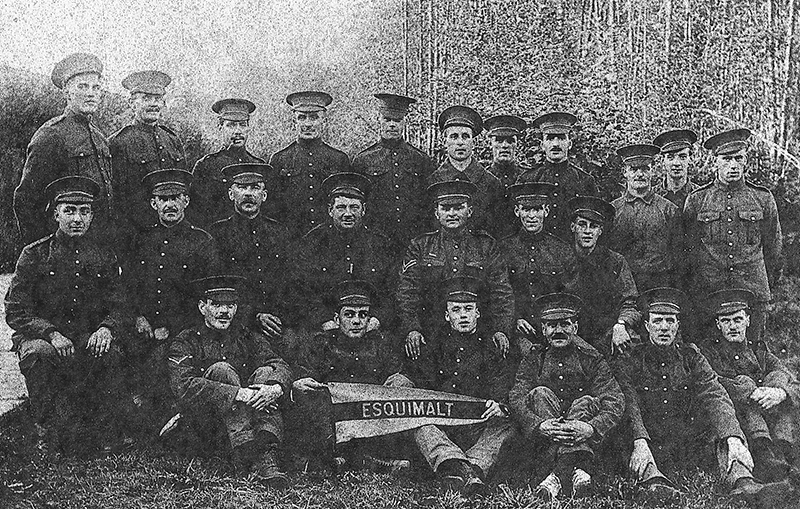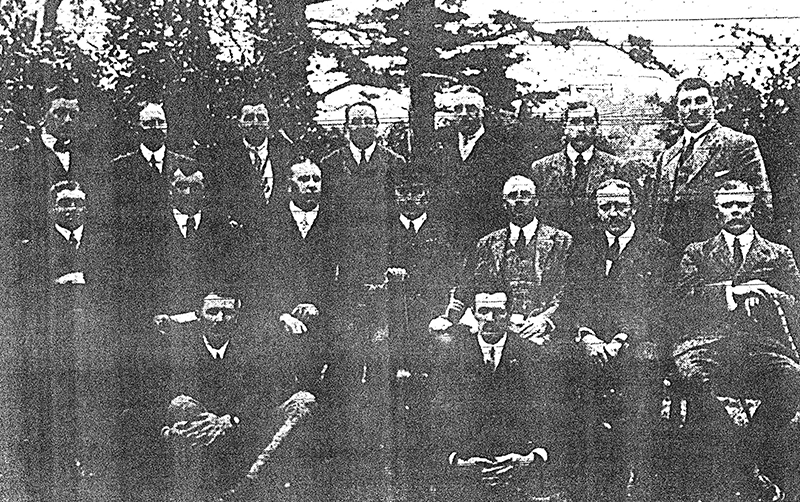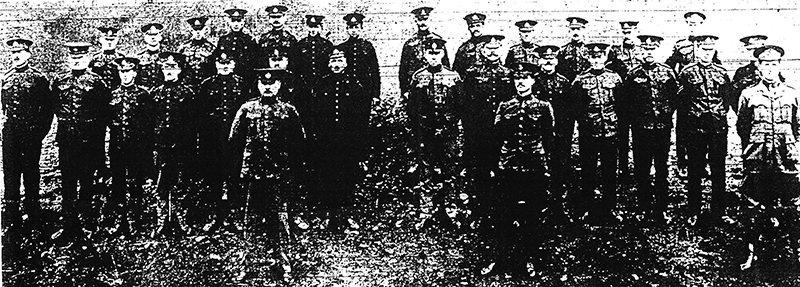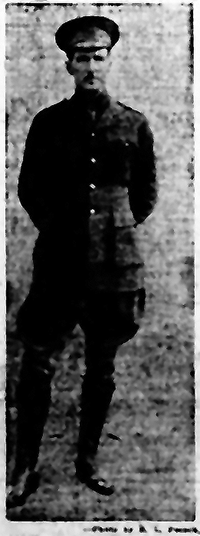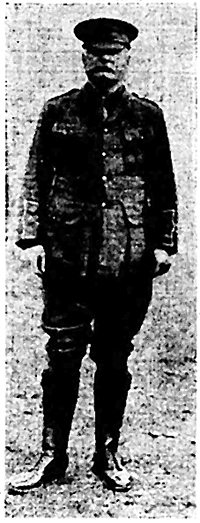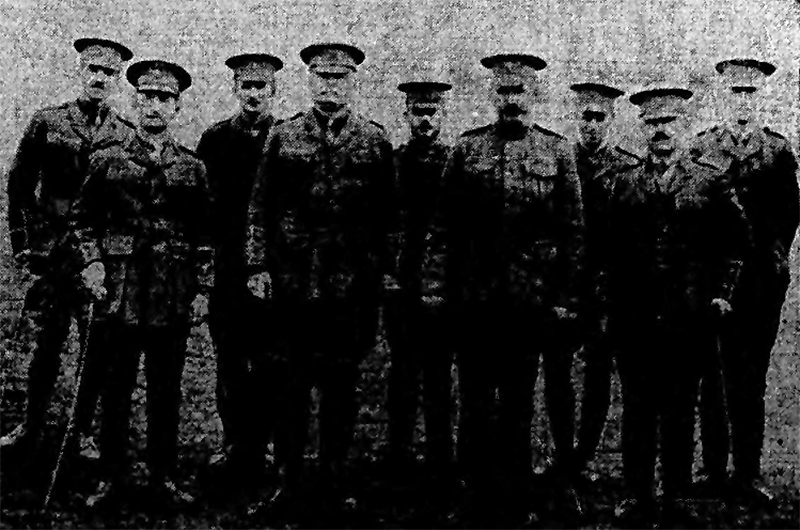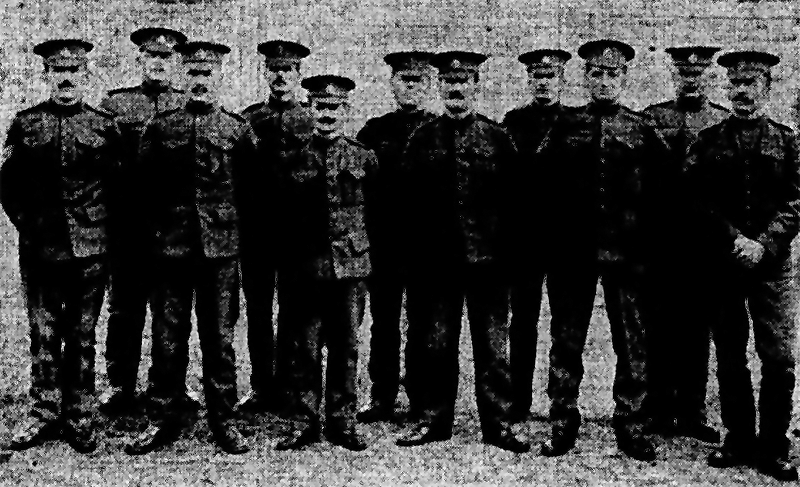 |
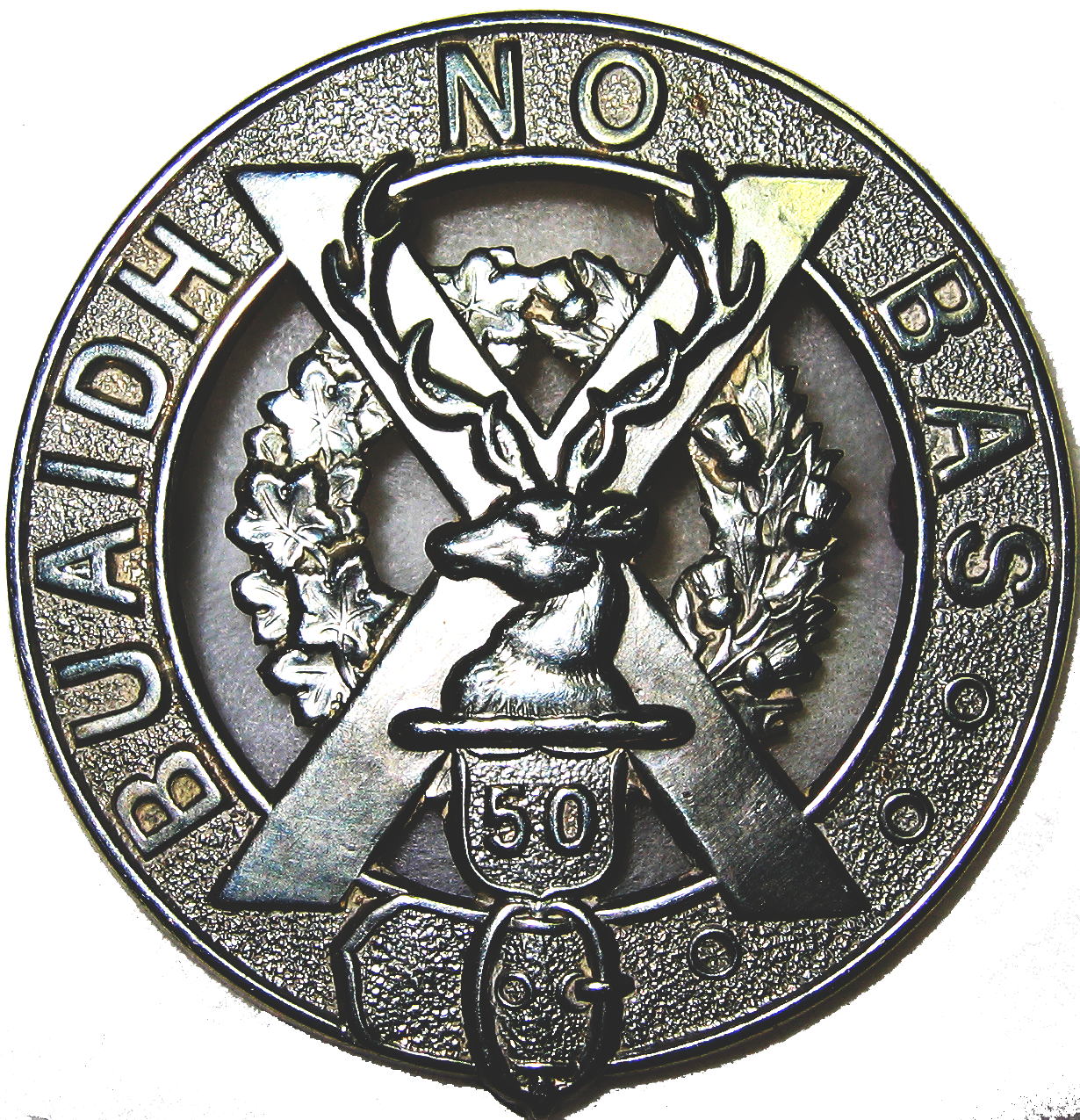 OPCMHVisitor No.: |
HISTORY OF WORK POINT BARRACKSby Jack BatesPART 4 — 1907 to 19181915COLONIST DUKE OF CONNAUGHT IS AT VERNON TODAY Governor-General and Party Spending Day in Inspection of British Columbia Troops H.R.H. the Duke of Connaught and party are due to reach the British Columbia mobilization camp at Vernon, B.C., today. They will be met by Col. J. Duff Stuart, the D.O.C.; Col. Gregory, the camp commandant, and members of the latter’s staff. The entire day will be spent at the camp by the Royal party, the greater part of the time being occupied by an inspection of the troops. The Governor-General is due to reach Victoria at 5 o’clock on Thursday. A guard of honor is to be furnished by the Royal Canadian Regiment. He will spend a week in this city and next Monday, July 24, will pay a visit to Sidney for the purpose of inspecting the 143rd Battalion, B.C. Bantams, and the 231st Seaforth Highlanders. Daily Colonist This is when my uncle, my mother’s younger brother, Walter James, was born. The newspaper announcement, as mother’s, read simply:
COLONIST ELLIOTT’S HORSE ARE WITH THE CONTINGENT Committee Representing Local Cavalry Corps Deny Report That They Were Stranded in London Concerning the report that Elliott’s Horse, the corps of cavalry which was mobilized in Victoria and, after training, sent to England at the expense of some public spirited citizens, Troopers William K. Walker and Robert Lowe, representing the company, have written the Colonist a conclusive and self-explanatory letter. It follows: “Salisbury Plain,” 25th December, 1914.
W.K. WALKER OPCMH Daily Colonist It is announced that “The Detachment of the Permanent Army Service Corps, Work Point Barracks, reports that one or two good reliable teamsters and clerks are required. There is a very good opportunity for young men in this branch of the service for advancement. The pay on joining amounts to $1 per diem and corps pay, everything found. Further particulars regading the service this unit provides, etc., will be given to anyone inquiring at the office.” REGIMENTAL ORDERS Legion of Frontiersmen Victoria Sub Unit – A meeting will be held today, February 24, 1915, at 6 p.m., at Frontiersmen headquarters, Camosun Building, 1203 Langley Street. Dress – full dress without holster. All Frontiersmen in the city and district are requested to be present. Any men wishing to join are invited to attend. The following has been taken on strength of the Legion: Trooper Joseph Hudson. By Order COLONIST TRANSFERRED TO STRATHCONA HORSE Ottawa - March 3. A letter received here from an officer of the Strathcona’s Horse says that about 50 of the members of Elliott’s Horse have been transferred to the Strathcona’s Horse to replace men discharged as medically unfit, or for other reasons. The Strathcona’s Horse was still in Winnipeg on the day on which the letter was written. April 25, 1915 Esquimalt Gun Club Owing to alterations and improvements being made to the trap house, the usual weekly shoot of the Esquimalt Gun Club will not take place today. May 23, 1915 EFFICIENCY HAS BEEN OBTAINED Remarkable Record is Made by Military District No. 11, Heart of Military District From Work Point, ever since the war’s start, has been directed the machinery which has made it possible for British Columbia and the Yukon to climb from a place of minor importance in the estimation of Canadian military authorities to a position which, admittedly, merits primary consideration. Guided by the rare executive ability of Col. Ogilvie, whose sound judgment has been proved by results, the officers gathered about him have been able to mobilize and train thousands, many of whom now are demonstrating their worth on the battlefield. Through Col. Ogilvie’s office, the staff of which consists of only Major Moore, D.S.A., Lieut. Sisman and seven clerks, is directed all the activity, generally speaking, of the military forces of the district. Ottawa’s instructions are received and communicated in amplified form. Hundreds of inquiries are received and dealt with. Mail, as marvelous in its variety as in its bulk, is received and answered. And, in addition to these details, the supervision of recruiting more and yet more men, for active service goes on day after day. Since Col. Ogilvie took charge ten units have been organized, namely, the 29th and 30th battalions, the 11th Canadian Mounted Rifles; the 47th, 48th, 54th, 62nd, 67th, 72nd and 88th battalions. The latter, of course, has not yet been completed. Recently there have been authorized the 102nd, the 103rd, and the 121st. Two companies of the Army Service Corps have been raised as well as five sections of the Field Ambulance, one remount company, three or four signaling sections, two cyclists sections, about six drafts of Canadian Engineers, with a strength of 50 each, 250 men to reinforce a Montreal battalion, 200 for the Royal Canadian Regiment at Halifax, two drafts of 50 each from the 5th Regiment, C.G.A. to reinforce field artillery batteries in England, and a draft of three officers and 100 men from the same regiment which is awaiting orders to move. VANCOUVER DAILY NEWS ADVERTISER June 15, 1915 REACH HIGH PITCH OF EFFICIENCY Naval Volunteers Trained at Esquimalt Are Doing Excellent Work On August 5, 1913, the Royal Naval Canadian Volunteer Reserve was formed. Just nine months later, in May of last year, the naval organization was officially recognized. Much has been accomplished since that time, for today the R.N.C.V.R., Pacific Coast Division, is one of the most efficient volunteer naval units in existence. The Pacific division is composed of two companies, No. 1 Victoria and No. 2 Vancouver., Commander John T. Shenton, R.C.N., officer commanding, Pacific sub division, R.N.C.V.R. Splendid progress has been made in recruiting for the Naval Volunteer movement since its inception, no less than 750 men being on the books at the Esquimalt Navy Yard. The movement received great impetus following the outbreak of war in Europe last August. At the present time there are 211 Naval volunteers stationed at Esquimalt, which include those men now serving in the submarines and lent to H.M.C.S. Rainbow, and the number of recruits is being added to daily. The total strength of the R.N.C.V.R. has been considerably decreased in recent months by the transfer of drafts to the various branches of the Canadian service, while many men have secured their release in order to proceed on active service with the forces in Europe. Some In The Trenches Some of the naval volunteers are in the trenches in Flanders while others have joined the Army Service Corps and the Army Medical Corps, and not a few are now serving with the Royal Flying Corps. Over 200 men have been dispatched with naval drafts principally to the eastern Canadian coast. Fifteen are attached to H.M.C.S. Niobe, and fifty are serving with H.M.S Diana, both vessels being stationed at Halifax, N.S. Others are engaged on patrol duty on the Atlantic coast of Canada. Thirty seven naval volunteers are now serving aboard H.M.C.S. Rainbow, and seven can be accounted for on H.M.S. Newcastle. The submarines are almost entirely manned by naval volunteers. Thus it is seen that men, landsmen for the most part, who had instilled into them at Esquimalt all they know about the naval business are scattered far and wide, serving their King and country as true British sailors. Esquimalt is an ideal spot for training the naval men. Every facility is provided fro initiating them into the mysteries of naval tactics and gunnery. Serving with Commander Shenton, R.C.N. is an efficient staff of officers and instructors. With a combination of this character and it is not surprising that the average landsman is licked into shape for sailor’s work within a comparitvely few months. Upon being accepted, the Naval Volunteer is given the customary outfit, known as the kit bag, with a hammock for sleeping purposes. Course of Instruction After being taught the rules of naval discipline, he is put through squad drill. Then comes lessons in boat pulling, sailing, knots and splices, rifle drill, and 4 inch gun and maxim drill. Morris tube firing is also a feature of the instruction classes and special attention is paid to rifle drill. After four months of this training, the Naval Volunteer is in line for the efficiency class, to pass as an ordinary seaman. For some seamen there is an advanced course open to the volunteer, which includes compass instruction, heaving the lead, patent sounding machine drill, signaling, rules of the road, wire splicing and learning to take charge of a boat under car and sail. Gunnery instruction is a feature of the naval volunteer’s work at Esquimalt. The recruits readily take to gunnery, and always appear eager for more when the order is given to “cease firing.” For this instruction there is provided a special dummy arrangement fitted with the regulation breach. Dummy 6 inch shells of the size and weight of the ordinary service projectile, are used for loading operations. The weight of these dummy projectiles is 100 pounds. Great rivalry exists between the gun crews, and some good records are made by the naval volunteers. Eighteen rounds a minute is a record for an officer’s gun crew. When being put through gunnery instructions yesterday, a comparatively raw gun crew of recruits, the majority of whom had only been in training for two months, timed with a stop watch, fired fifteen rounds a minute, while a mixed gun crew of officers and men made sixteen rounds within the same period. Officers of the R N.C.V.R. state that the Naval Volunteers stationed at Esqumalt station are open to enter into competition with any gunnery volunteer naval units in the country. Personnel Continued ... Lists of names. June 20, 1915 Colonel Alexandre Roy, M.V.O., formerly district officer commanding Military District No. 11, is retired, and is granted permission to retain his rank. June 26, 1915 PREMIER TAKES WITNESS STAND Gives Evidence Before Royal Commission at Ottawa in Regard WERE NECESSARY FOR COAST DEFENCE Statement That Suspicious Circumstances Attended Purchase - Without Foundation in Fact Ottawa, June 25 – Sir Richard McBride, Premier of British Columbia, took the stand at a late hour this afternoon before Sir Charles Davidson, at the investigation commission. Sir Richard stated that he had seized the opportunity to make a statement concerning the purchase of two submarines from the Seattle Construction & Drydock Company, just before the declaration of war last August. He declared that he felt the step which he had taken was entirely warranted, and was willing to take full responsibility. “Because of the existence in local waters of two German warships,” said Sir Richard, “and the defenceless nature of our coast cities, there was a great deal of nervous tension among our people. It appeared to me that something should be done to afford home protection for our coast cities. We are 3,000 miles from Ottawa, and it is not always easy to get immediate connection. I, therefore, took upon my own responsibility to purchase these vessels, and I intended to have the Province of British Columbia foot the bill, if, in its wisdom the Federal Government considered the step to have been unwise. It is difficult,” continued Sir Richard, “to make the people of Ottawa understand the undefended condition of our coast. This is not the occasion to talk of defence, but I have expressed myself freely at other times.” The price paid was $1,150,000. Captain Logan had made the purchase from Mr. Patterson, of the Seattle company. Not Suspicious “The statement has been made through the Auditor General,” continued Sir Richard, “that the transaction was a suspicious one. I want to say that anything so circulated through that official is unfounded. It has been said that the vessels are inefficient. Lieut. Jones and Commander Keyes had inspected the vessels, and both had declared that they were highly efficient and up to date. The vessels are now in Esquimalt harbor and open for the inspection of any unbiased person.” On the question of price he could only gauge it from a conversation with Commander Pilcher, who had told him that a similar vessel in England would cost $710,000. Through some misunderstanding Mr. Barnard, M.P. for Victoria, had heard by long distance conversation with Seattle that the vessels could be obtained for $375,000 each. “With two cities threatened by a hostile fleet,” said Sir Richard, “we could not hesitate about the price. Captain Logan, of Lloyds, had gone to Seattle and negotiated the price. He reported over the long distance telephone that they could be procured for $1,150,000.” Sir Richard declared that the Chilean Government, for whom they were built, had failed to pay the money, and that this was the reason why they had been disposed of. Sir Richard did not know what the contract price with the Chilean Government was, but Mr. Patterson of the Seattle company, said the price was reasonable. “Was anything paid as commission or for the campaign funds?” asked the Commissioner. “Not one cent, directly or indirectly,” answered Sir Richard. The witness stated that the ships were secured several hours before war was declared. Later and investigation was instituted by the United States Department of state, at the instigation of the German embassy, to find if there had been a breach of neutrality. Auditor General The Auditor General was asked whether he desired to ask any questions. He stated that he was satisfied with what Mr. Thompson had asked, but believed that Mr. Patterson from whom, the vessels were purchased, should have been brought to Canada to testify. He declared that his action in investigating the circumstances of the purchase was warranted by certain suspicions voiced abroad by the statements in the Seattle papers and by private statements made to him by individuals. It was his duty as Auditor General to look into the matter under these circumstances. Sir Richard interrupted here “It is enough to discourage a man from giving service to his country,” he declared with heat, when one finds men through political bias and partisanship imputing all sorts of underhand and damnable motives.” “Do you include me among those?” asked the Auditor General, dryly. “I hope not,” said Sir Richard. It was decided to ask Mr. Patterson to appear, and also to secure a statement from the company by which the boats were designed. COLONIST SIR RICHARD UTTERS PROTEST Premier, In An Interview, “As I have asked that the investigation now proceeding in Ottawa by Royal Commission should be extended to Victoria, one would imagine that the Liberal papers would have the decency not to make further comment until the result of the inquiry was made public,” said Sir Richard McBride yesterday, when interviewed about the submarine’s purchase. “On the other hand,” he went on to say, “they have continued to publish innuendoes – mostly from outside and irresponsible sources – the contemptible because they simply imply mush that they dare not put into so many words.” “When the investigation takes place evidence will be given by Mr. Patterson, President of the Seattle Dry Dock and Construction Company, Capy. Logan, myself and others, as to all matters connected with the purchase.” Sir Richard has written a letter to The Advertiser of London, Ontario, extracts from which, almost libelous in their character, appeared in the Times under the heading of “Premiers and Drug Clerks.” The Colonist is permitted to publish the letter, which is as follows:
July 29, 1915 FIRE AT ESQUIMALT Head Street Residence Gutted While Occupants Are Absent – Contents Are Saved Fire which started on the roof almost completely destroyed the residence of Mr. H. R. Heigh, at the cornr of Head and Dunsmuir streets, Esquimalt, last evening. When the fire was first seen by neighbours, the flames had worked their way into the attic, which was ablaze, and by the time the neighbours reinforced by a squad of soldiers from Work Point Barracks had gathered and commenced getting out the contents the building was virtually doomed. How the fire started is a mystery. Mr. Heigh, who occupied the premises, and the family were at the Gorge, and there was no one in the house at the time. Owing to the excellent work of the soldiers and others a large part of the valuable contents were saved, the soldiers bringing along hose and other equipment. The dwelling was close to the old brewery premises of the Victoria Phoenix Brewing Company, now occupied by the San Juan Mining & Manufacturing Company, and this latter structure had to be closely watched. Owing to the fire being outside the city limits the city apparatus was not used. July 30, 1915 RANK OF CAPTAIN GIVEN LOCAL OFFICER Gazette Contains Notice of Promotion of Lieut. A Mulcahy Lieutenant Andrew Mulcahy, of the Royal Canadian Garrison Artillery, has been given the rank of Captain. Notice to this effect is contained in the recently issued military general orders. Having been identified with the local military forces for years, and for some time connectd to the permanent force at Work Point Barracks, the news will be received with gratification by Captain Mulcahy’s many friends. Other appointments are:
August 1, 1915 MOBILIZATION OF B.C. BASE HOSPITAL Canadian Medical Corps, Now in Camp on Macaulay Plains By tomorrow morning the entire establishment of the Canadian Medical Corps, No. 5 General Hospital, with the possible exception of the nurses, will be mobilized on Macaulay Plains. A number of the officers of Vancouver and other outside points came yesterday, and also many of the nursing staff who have been recruited elsewhere, some, however, were unable to complete their personal arrangements in time to be in the city last week end, and are expected to report today or at an early hour on Monday. Provision has been made for the accommodation of all who hold commissions at the camp, which will be occupied from their arrival until the hospitals departure. The nurses are making their own arrangements as to quarters, but will be required to spend a considerable part of their time within the lines immediately prior to their departure. It was on June 8th last, or thereabouts, that the organization of the establishment was commanded by Lieut. Col. E.C. Hart, the officer commanding. In the short interval he has practically completed his task, being assisted by a number whose services were enlisted shortly after authorization came to hand. Thirty five officers, the majority being practicing physicians and surgeons of British Columbia, have volunteered and been accepted, seventy three nurses have offered to go to the front to assist in caring for the wounded and are on the roll, and 200 rank and file have been recruited. The latter were mobilized under canvas at Macaulay Plains, and for about seven weeks their training in all branches of first aid work and in military discipline has been in progress. The mere enumeration of what has been accomplished gives the outsider no proper conception of the amount of work done, or of the executive ability required to dispose of the innumerable details satisfactorily. The corps is now in shape to leave and that everything should have been so thoroughly done in such a short period reflects the highest credit on Col. Hart and his staff. Training of Corps The course through which their non commissioned officers and men have been put has kept them busy every day since the camp’s opening. From the sound of reveille immediately followed by physical jerks until late in the afternoon, the entire personnel was active, and thereafter a proportion of the N.C.O.’s and men were engaged in guard and fatigue duties. One of the most interesting features of the work to the rank and file were the daily lectures on first aid which were given by the following: Major Burris, Kamloops; Capt. Clarke, Vancouver; Capt. Wilson, Vancouver; Capt. Miller, Rossland; Capt. Wall, Prince Rupert; Capt. Schinbeim, Vancouver; Capt. Campbell, Vancouver; and Capt. Hanington, Wilmer, B.C. Of the doctors who have volunteered, a number are prominent in Victoria. In addition to Lieut. Col. Hart there are Lieut.Col. Herman Robertson, Capts. Gibson, Walker, Whillans and Mart, the latter being a dental surgeon. They are all sacrificing their local practices in order to be of service to the Empire. The seventy three nurses in the establishment include twenty three from this city, many of whom are graduates of the city’s leading hospitals, namely, the Jubilee and St. Josephs. A great part of the equipment necessary has been supplied. Most has been secured as a result of public appeals throughout the province. Victorians have subscribed sufficient to furnish three ambulances which have been ordered from the Russell Manufacturing Company of Toronto, Ont., and will be delivered as the hospital passes through Eastern Canada en route to the old country. Funds are also being provided for other needed supplies, so that the British Columbia base hospital should have all the facilities needed to give it the maximum of efficiency. To indicate the importance of this phase it may be pointed out that the hospital is supposed to have 1,040 beds, or to care for twice as many patients as are handled by the Vancouver General Hospital with half the staff. That the corps will receive word to leave at an early date is forcasted, not only by the general mobilization of its personnel, but by the fact that the N.C.O.’s and men were given their last leave on Saturday. It expires tomorrow morning, and from then until departure the force will be on duty continuously, except in exceptional instances. Photos: By Jones: Non Commissioned Officers of C.M.C., No. 5 General Hospital August 3, 1915 SEEKING RECRUITS Vacancies in Field Ambulance Corps – Detachment Will Leave For Vernon Shortly Recruits are wanted for the field ambulance corps. Applicants should make a point of communicating with the staff sergeant, Work Point Barracks, at or about 10 a.m. daily. The detachment will proceed to Vernon in a week. Within the last few days men have applied for places with the Canadian Medical Corps, No. 5 General Hospital. Being unable to obtain places on the strength of this unit, the majority have gone with the field ambulance. As McLoughlin Point (Maclaughlin Point) was adjacent to Work Point at this time, and is currently landlocked within Work Point Barracks circa 1942, I have included the origin of the Imperial Oil Bulk plant. Also see August 13, August 19 and September 14, 1915; January 7, March 14, June 18 and November 27, 1916; and February 16, 1917. August 3, 1915 WILL ESTABLISH OIL PLANT HERE Imperial Company Buys Site at Maclaughlin Point The Imperial Oil Company has purchased five lots adjoining one another along the waterfront of Maclaughlin Point, Esquimalt, immediately oppositethe outer wharves. On the land secured an extensive oil plant will be established. At present all the oil used by the Imperial Oil Company is sent to Ioco, where large refineries are maintained for the purpose of dealing with the crude product shipped from Peru. The size of the Victoria plant is not yet known, but a wharf will be constructed to accommodate the oil tankers while they discharge their cargos. The site where the plant is to be constructed extends from the central portion of a small beach, known as Sailor Bay, to a point a short distance from the Maclaughlin Point fog horn. The property commences at the water and reaches to Victoria View road. The land which is to be occupied is densely wooded with fir trees and underbrush, but the task of clearing will be significant in comparison with the removal of rock, which will be a considerable undertaking. The rock is of a heavy nature, but will be utilized, when excavated, in filing up the low lying portion of the property, part of which becomes a marsh during the winter. A small workhouse was installed at the site yesterday and this will be used as temporary headquarters for the mechanics and blacksmiths, as well as the contractors, who will start operations immediately. Surveyors have been working on the property for the last week. The water in front of the land is fairly deep, and will be suitable for the passage of good sized vessels without much dredging, while the rock will form a substantial foundation for the wharves. Distributing Centre The chief purpose of the plant will be to act as a distributing centre of oil for Vancouver Island and other adjacent places. Crude oil for the island will be brought here instead of to Ioco, and thus the expense and labor of sending the oli back from Burrard Inlet will be eliminated. The refined oil will be sent up the island by railroad. The road leading to the site will probably be levelled in order to facilitate the haulage of heavy machinery and material. The entire supervision of the work is under Mr. A.M. Abbey, a representative of the company. The property was purchased several weeks ago by the Imperial Oil Company from the Hudson’s Bay Company, which had held it for many years. The selection of the site on Maclaughlin Point followed an examination of the waterfront property along the harbor. August 11, 1915 LIEUT. J.C.P. VERSTURME-BUNBURY At present the commandant of the Royal School of Instruction for Lieutenants, which is in progress at Work Point Barracks with a branch at Vancouver, B.C. The local course opened some time ago and the thirty-nine candidates for qualification are reported to be making considerable headway. The mainland school, which also is under the same officer’s superintendency, started last Monday, and there are sixty odd students. Lieut. Versturme-Bunbury, who has taken over the duties of Major Seeley Smith, R.C.R. is shown in the accompanying picture wearing the uniform of the South Staffordshire Regiment. He served in the 2nd Brigade of that regiment in Pretoria, S.A. from February 1909 to January 1911 and was with the 1st Brigade in Gibralter from Feruary 1911 to Augusr 1912 joining the 72…outbreak of the war he became attached to the Royal Canadian Regiment in November of last year. Photo. August 13, 1915 Esquimalt Street Improved - A number of men are at work on Victoria View road, Esquimalt, grading the surface to give better facilities to the trucks, heavily laden with machinery required at the new Imperial Oil plant. This road improvement was proposed at the last meeting of the Esquimalt Council by the Imperial Oil Company, and the cost having been ascertained, approval was given. The road will be sufficiently graded in the course of less than a week. August 19, 1915 MAKE START ON OIL TANK CONSTRUCTION Undertaking at Maclaughlin Point Beginning to Assume Larger Proportions Work on the new oil plant on Maclaughlin Point, which will be operated by the Imperial Oil Company, is assuming larger proprtions. The entire site is now a scene of activity. The contractors, Messrs. McAlpine & Robertson, have a big gang of men working, and the numerous visitors testify to the general interest which the construction of the oil plant has aroused in Victoria. A barge laden with iron sheeting arrived on Monday from the Imperial Oil Company’s former plant at Impoco, Burrard Inlet, and it was engaged for two days in discharging its freight by derrick. The sheeting was unloaded along the waterfront adjacent to the plant, and by means of horses, was carried into position. The material will be utilized in the erection of the largest of the several tanks, and what has alreadyarrived is being used on the construction of the base. A number of iron workers are now being engaged, and reviting commenced yesterday morning. Another barge load is expected within the next few days, and operations will be continued as rapidly as possible, so that the plant will be ready for occupation this time next year. The road leading to the site is being levelled under a separate contract, and this undertaking will be finished in a week or so, thus allowing free access for heavily laden drays with machinery necessary for the construction of the oil reservoir. August 29, 1915 TRAINING AT WORK POINT Below is a group photograph of officers who have been attending the Royal School of Instruction for lieutenants, under Major J.C.P. Versturme-Bunbury, at Work Point Barracks: Front Row: - Lieuts. R. Carmichael, 11th Regt; D.H. Hepworth, 104th Regt; W.T. Haines, 107th Regt; C.O. Carbould, 104th Regt; G.B. Benson, 88th Regt; H.S. Whiteside, 104th Regt; G.L. Hamilton, 50th Regt; J.A. Cresswell, 6th Regt; O.T. Blair, 72nd Regt. Sitting Down: - Lieut. H.E. Barnes, 107th Regt; Capt. E. Mallandaine, 107th Regt; Sgt. Major Youngman, instructor; Major J.C.P. Versturme-Bunbury, R.S.I; Lieuts. A.G. Forster, 68th Regt; James T. Lee, 11th Regt; F.J. Dawson, 102nd Regt. Standing: - Lieuts. E.L. Fullerton, 68th Regt; J.J. Martin, 107th Regt; W.G. McIntosh, 72nd Regt; R.P.H. Baird, 88th Regt; M.P. Lane, 102nd Regt; G. Lyon, 11th Regt; A.P. Foster, 72nd Regt; R. Howard, 88th Regt; G.S. Gladwin, 107th Regt; G.T. Thomson, 107th Regt; P.E. Doncaster, 104th Regt; R.A. Barton, 102nd Regt; D.M. Christie, 72nd Regt; Hon. Angus McDonnell, 6th Regt; B. McDarmid, 104th Regt; T.E.L. Taylor, 102nd Regt; R.H. Ley, 88th Regt; E. Renouf, 6th Regt; C.M. Ross, 50th regt; J.E. Kennedy, 6th Regt; G. Cruickshank, 107th regt. 88th VICTORIA FUSILIERS The 88th Victoria Fusiliers have a unique record in the Canadian Military service .... Click to view article. (PDF) COLONIST 88TH REGIMENT HAS SPLENDID RECORD This article is about the contributions of the 88th Regiment (Victoria Fusiliers) to date with photos of the officers, sergeants, No. 1 and 2 platoons of the No. 1 Training Company. The present Commanding Officer is Lt. Col. HJ Rous Cullin. September 14, 1915 OIL COMPANY WILL BUILD LARGE WHARF Structure is to Accommodate Tank Steamers The plans made with regard to the construction of the Imperial Oil Company’s new plant at Maclaughlin Point are rapidly materializing, and very noticeable progress is being made in the erection of the tanks, which are to constitute the largest and most important feature of the establishment. The big fuel tank, work upon which commenced a little over a month ago, has been practically complete. The full height of the structure has been reached and the basehas been tested and found watertight. As soon as the covering, which will be of iron, is installed the reservoir will be ready for regular use. Favorable progress is being made with two smaller tanks which will accommodate distillate and coal oil. They will be tested shortly. Mr. Angus M. Abbey, local epresentative of the Imperial Oil Company, stated yesterday that the whole plant will be ready for occupation about the beginning of next spring. The present quarters of the company on Florence road will not be abandoned until the winter weather is past. In the meantime machinery is being transferred from the Florence road plant to Maclaughlin Point, and barge loads of iron sheeting are regularly arriving from the former reservoir at Impoco, on Burrard Inlet, which is being put out of commission on account of the success attending the maintenance of the storage plant and refinery at Ioco, further up the inlet. The rock bases for the other tanks, probably three or four in number, have been graded to the proper level, and covered with impervious clay. Clay will be used as the bottom for all the small tanks and work on their construction will commence almost immediately. Wharf at Site Particulars with regard to the wharf which is to be built at the site are available. It will be a T shaped structure, and the part jutting out into the water will be 150 feet long, while the wharf proper, or crossing of the T, will also be 150 feet in length. The pier will provide ample accommodation for the tankers Asov and Cadde, which are the crude oil tankers for the company. The warehouses, for the construction of which no contracts have yet been awarded, will be 80 feet long and 40 feet wide. The water outside the wharf is now about 25 feet deep, but it is expected that a channel of 85 feet in width will be dredged there next year, which will have an average depth of 30 feet. It is intended to have the tank steamers, which discharge their cargoes at Ioco from Peu, come here in ballast with machinery and other material from Imoco, thus making it unnecessary to charter vessels not owned by the company. Stables, 64-1/2 feet long by 33-1/2 feet wide will be built in the course of a few days, arrangements for their construction being under way. Water is temporarily being taken to the plant by an exposed pipe, but in three weeks time another rline of pipe will have been installed three feet below the surface for permanent use. The road, which is being levelled for the easier access of heavily laden trucks, has practically been finished, a great deal of rock having been removed by blasting. COLONIST INQUIRY OPENS MONDAY NEXT Sir Richard McBride Will Not Be Represented by Counsel During Sir Richard McBride stated yesterday that it was not his intention to have either himself or the government represented by counsel at the forthcoming inquiry by Sir Charles Davidson into the matter of the purchase in August, 1914, of two submarines from the Seattle Drydock & Construction Company. Sir Richard added that the crown was represented by very able counsel in the person of Mr. John Thompson, K.C., who could be depended upon to bring out all the facts of the case. In this connection it may be mentioned that according to reports appearing in the Liberal press, it is the intention of the Liberal Party to be represented at the inquiry by Mr. S.S. Taylor, K.C., who is to be given a watching brief. Sir Charles Davidson, according to an intimation received by Sir Richard some days ago, is due to reach Victoria on Monday next, and it is assumed that the inquiry will be instituted immediately upon his arrival, the sessions, which will be open to the public, being held in the executive chamber at the Parliament Buildings. The chief witnesses to be examined outside of Sir Richard himself, who made the purchase, are expected to be Mr. J. Patterson, president of the Seattle Drydock & Construction Company and Capt. W.H. Logan, Lloyd’s agent at Victoria, who acted as agent for the Provincial Government in the matter of arranging terms of payment and delivery of the submarines to the naval departments at Esquimalt. October 6, 1915 (5) SIGNAL HILL GUNS MAKE GOOD PRACTICE Heavy Ordnance of Esquimalt Fort Engages in Firing Test With Excellent Results To local military men an event of special interest took place yesterday, when the 9.2 guns of the Signal Hill battery were first fired. Six rounds in all were discharged, three from each of the guns. The target was at a range of about 8,500 yards, a point some distance off William Head. With beautifull clear weather, the atmosphere being entirely free from the haze and smoke which interfered with the shooting last week, the gunners were able to see distinctly the six foot square canvas target which had been anchored by a launch for the practice. The exercise took place under the best of conditions. It had been arranged that a start should be made at 11 o’clock, and the D.O.C. through the commander, Capt. Mulcahy, had given permission to a number not actually identified with the batteries, to be in attendance. Lieut. Col. Angus, commanding the 5th Regiment, C.G.A., several of the officers of that corps, and a number of squads from the same body, were present. Major Moore, the D.S.A. was among the other interested spectators. As soon as the target had been replaced, Capt. Mulcahy gave the necessary orders, and shortly after the entire Esquimalt district was shaken with the concussion of a discharge. The shot struck the water close to the side of the mark. Another followed and it hit in about the same place. The third was a trifle short, and to the right, but would have taken effect on a ship lying where the buoy had been placed. The three last sent columns of water into the air directly over the target. The shooting was declared to have been exceptionally fine. Each landed within a few yards of its objective, and three were in direct alignment. Afterwards, the officer in command, those in direct charge of the batteries, and others, were congratulated. House Were Shaken As the people of the Esquimalt district whose homes are in the immediate vicinity had been warned, the detonations did not do as much damage as otherwise would have been the case. All windows were opened so that they escaped being smashed. The residences of Major Moore and Major Belson which are close to the fortress, suffered somewhat. The plaster was knocked from the walls of most of the rooms in Major Moore’s house. It was decided to hold the practice at short notice, a special request having been made to Capt. Mulcahy to take advantage of the exceptional conditions, inasmuch as it was his birthday, and the anniversary of his taking up military service. That officer, who is exceedingly well known and very popular in Victoria and district, is 53 years of age, and has worn the uniform of a soldier for thirty-five years. He is considered among the most efficient of the commissioned military men of the Canadian west, and it was fitting that these two milestones of his career should have been marked by the excellent shooting of the men of the Royal Canadian Garrison whom he has been engaged in training. Capt. Mulcahy announces that he requires about eighteen recruits. He has obtained authority to enlist men in the R.C.A. Signal Hill battery, for the duration of the war. Applications should be submitted to him at Esquimalt.
COLONIST GARRISON SPORTS TAKE PLACE TODAY FINE PROGRAMME OF ATHLETIC EVENTS TO BE HELD AT WORK POINT Arrangements have been made by the members of No. 5 Company, Royal Canadian Garrison Artillery, for a field day this afternoon, at Work Point. It will start at 1:30 p.m. The 5th Regiment, C.G.A. band will be in attendance. No. 5 Company is commanded by Captain Mulcahy, and has charge of the big guns at Signal Hill. All are looking forward to a good time. The programme will include the following:
October 14, 1915 ESQUIMALT MEN IN CANADIAN PIONEERS
The corps which is commanded by Lieut. Col. A.E. Hodgins leaves Vancouver on Saturday for Winnipeg, going from there to England in the course of the next three months. The names of those appearing in the above photograph are: Left to right, back row – Ptes. Ricketts, Burnett, Barclay, Doran, Heald, Guest, Martin, Thorburn, Phoenix, West, Simpson; sitting, middle row – Ptes. Holt, Whittaker, Worth, Williams, Cpl. Lock, Ptes. Ricketts, Hicks; bottom row, sitting – Cpl. Taylor, Ptes. Finmore, Hines, Humphries, Finlay and Trenchard. COLONIST SHOWING GROUP OF B.C. OFFICERS TAKEN BEFORE WAR
The above was secured at Work Point Barracks immediately after the Summer training of 1914, and not more than a month prior to Great Britain’s declaration of war against Germany. Most of the well known military men of the Province are included, and it is interesting to note the large proportion who have distinguished themselves either on the field of battle or in other important spheres of activity. Following are the names, together with their present ranks and honors: Back row, standing, left to right – Major G.B. Hughes, now Brigadier General and D.S.O.; Major Lorne Ross, now Lieut. Col. And O.C. of the 67th battalion, Western Scots; Major Godson, D.S.O., wounded and invalided; Major Carey, Capt. Slater, Capt. Roberts, Capt. Dowding. Centre row, sitting, left to right – Lt. Col. Leckie, now Brigadier General and C.M.G.; Major Eaton, now Lieut. Col.; Lieut. Col. A.W. Currie, now Major General and C.B.; Col. Roy, then D.O.C; Lieut. Col. Duff –Stuart, now Brigadier at Vernon concentration camp; Major Lipsett, now Brigadier General and D.S.O.; Lieut. Col. Flick. Front row, left to right - Major Mathews, now Lieut. Col. And D.S.O., and Captain Power. COLONIST “A” GROUP OF SIGNAL HILL BATTERY – A-1 AND A-2 DETACHMENTS
OFFICERS AND MEN WHO MAN BIG GUNS No. 5 COMPANY, R.C.G.A., OF SIGNAL HILL FORT, No. 5 Company, Royal Canadian Garrison Artillery, which is in charge of the 9.2 guns of the Signal Hill Fort, Esquimalt, and pictures of the personnel of which appear in this issue, is often confused with the 5th Regiment, Canadian Garrison Artillery. The actual inception of this force, the local company, of which is commanded by Captain A. Mulcahy, dates back to about 1870. It was formed in Kingston, Ont., when the Canadian authorities took over the garrison there, as well as Quebec and Toronto. Previously the garrisons had been supplied by the Great Britain. There are five companies of the R.C.G.A., two being stationed at Halifax, two at Quebec and one at Esquimalt. Captain Mulcahy, the O.C., relieved Col. A.T. Ogilvie when the latter took over the duties of District Officer Commanding shortly after the beginning of the war. He is one of the best known of Victoria’s officers and throughout his years of experiences, has earned a reputation for efficiency. There are few young men of this city now serving with the field or garrison artillery who did not obtain their first knowledge of the work under him. Entering the service in 1880 at Quebec, Captain Mulcahy immediately came in touch with two officers who have since been closely identified, at different periods, with Military District No. 11, Major J.G. Holmes (now Colonel) and for years the local D.O.C., was his commander. Captain Peters, only a short time ago D.O.C. of the district, was another officer. He served as a Sergeant through the rebellion of 1885, being present at the engagements of Fish Creek and Batoche, the latter being the event which resulted in Riel’s capture. Other Victorians he remembers being there are Mr. J.G. Brown, Captain Beaumont Boggs and Major Belson. Captain Peters was in command of the artillery. INDIAN REBELLION Returning to Kingston Captain Mulcahy was made staff – sergeant – instructor and shortly after was sent to Victoria with “C” Battery to form a garrison here. He was sergeant – major of the force which, while stationed in the city, was called on to go north to suppress a rebellion of the Indians of the Skeena River District. Lieut. – Col. The Hon. E.G. Prior, then commanding the 5th Regiment, went with the corps as quarter – master and the trip was made on H.M.S Caroline. There was no fighting, however, as, on the appearance of the red coats, the natives fled to the woods. In 1903 “C” Battery was recalled to Quebec, but only a month later Captain Mulcahy was transferred by Major General Ivor Herbert, then the G.O.C. of Canada, to act as sergeant – major and instructor of the 5th regiment, C.G.A. General Herbert’s policy was that the militia units should all be furnished with instructors from the permanent force. Up to 1904 Captain Mulcahy was identified with the 5th, and was one of the five who represented the regiment at the Coronation of King Edward in 1902. When the Canadian Government took over the Esquimalt defences Captain Mulcahy was transferred for duty with his own corps as a master gunner of the first class. In May, of 1910, he was given a commission, and in the same month of 1915 was made a captain. When Captain Mulcahy first entered the service the corps was known as the Royal Canadian Artillery. Before he left the 5th Regiment it had been divided into two branches, the Royal Canadian Garrison Artillery, with which he is attached, and the Royal Canadian Horse Artillery. Two batteries of the latter have been serving, with distinction, in Belgium for some months. SONS ON ACTIVE SERVICE He has two sons on active service, namely, Trooper Alex Mulcahy, of the Yukon contingent of Eden’s machine gun brigade, and Gunner Owen Mulcahy, of the 1st Battery, 1st Brigade, C.F.A., under Colonel Morrison. Lieut. W.F. Clarke, second in command of No. 5 Co., R.C.G.A., comes from Calgary. He spent two years at the Royal Military College, Kingston, afterwards receiving his commission. He was appointed to the R.C.G.A. and posted to duty at Esquimalt about a year ago.
Under these two officers No. 5 Company, as it is now constituted, has acquired marked proficiency in the handling of the big guns of Signal Hill fort, as was illustrated by the recent firing practice. A little over a week ago Captain Mulcahy was asked how many men he could spare for overseas duty. He stated that while he could not “spare” any, he thought he might furnish twenty – five. When the offer was laid before the men the entire company volunteered. The fort, of course, could not be left unmanned and so the O.C. selected the number stated, including N.C.O.’s and men, and they now are waiting news of the date of their departure. It is understood that they are to be assigned to duty on some of the coast guns at Lynn, England.
50th REGIMENT 50th REGIMENT MOVES TO OLD DRILL HALL Gordon Highlanders Leave Willows Camp and Establish Home on Menzies Street The 50th Regiment, Gordon Highlanders, moved from the quarters it has occupied at the Willows Camp ever since the beginning of the war to the old Drill Hall, Menzies Street, yesterday. This will be the home of Lt.-Col. Forsythe’s corps until further notice. Both officers and men have been comfortably provided for and are reported to be thoroughly satisfied with the arrangements. In a short time the corps will take over the furnishing of guards for the entire southern part of Vancouver Island. November 21, 1915 THE NEW DRILL HALL The new drill hall, which the public will soon have the opportunity of inspecting, is undoubtedly the finest structure of its kind in Canada, and there can be few anywhere in the world better designed for the purpose for which it is intended. A great surprise awaits those who will visit it when the doors are thrown open. More description conveys no idea of its noble proportions and its beautiful finish. From No. 1 band room in the turret to the great swimming bath in the basement, it is a very notable edifice. The simplicity of the finish is in keeping with the grandeur of the structure. The architect is Lieut. Col. Wilson, and he has brought to bear upon the preparation of the plans and the appointments generally a ripe experience in what is required in a building of that nature. The Department of Militia and Defence has shown a due appreciation of the requirements of this Western Outpost of Empire in authorizing the erection of so fine a building, which of itself will serve as a great stimulus to the maintenance of the militia corps in this city during a time of peace. By its liberality the young men o f the community who desire to take military drill, will be able to do so in what is really a club house of majestic proportions and splendid appointments. The hall has been built by the Messrs. Parfitt Brothers, of this city, a firm of contractors whose name stands for work of high quality and reasonable prices. It seems almost incredible that this structure will be turned over to the Dominion Government at a cost of less than $300,000. November 27, 1915 Goes to Jail Convicted of sending anonymous letters, threatening his life, to Col. Sgt. Worthington, of “L” Company, R.C.R., Work Point Barracks, Pte. William Smith appeared before Judge Lampman yesterday and was sentenced to six months imprisonment. Asked to Report All those men who have not yet passed the mechanical tests for the Imperial transport service are requested to report at Work Point this afternoon at 2 o’clock. Uniforms for National Reserves After the regular drill on Wednesday last uniforms were issued to the thirty men of the National Reserve of Canada, No. 2 Company, Victoria. The uniforms are made from a good grade of khaki. The drill tunics are very neat in appearance, with the two breast pockets, seven brass buttons, shoulder straps, and are edged in red piping. The uniforms were made by Messrs. Turner, Beeton & Company, and are a great credit to the local industry. A card party and dance will be held on Monday, and the proceeds will be used in buyinhg more uniforms, which will only be issued to those men that are regular attendants at drill and are not eligible for overseas service. CYCLISTS’ PLATOON Unit Authorized Only Week Ago Practically at Full Strength Already The cyclists’ platoon, which was authorized about a week ago, and the mobilization of which was placed in the hands of Capt. Roaf, of the Intelligence Department, Work Point, has been brought practically up to full strength already. The number of capable young men, able to handle a bicycle, wanted was 29, and 28 are enlisted. There will be no difficulty in securing the one still wanted. In fact there are several applicants from whom to make a selection. An officer still has to be named, and, with his appointment, the platoon will number 30, which is the authorized number. December 12, 1915 MOTOR DRIVER’S CORPS Lieut. Copeland Will Receive Applications From Volunteers Local motor car drivers who wish to enter service with the Imperial Transport Corps, should make application to Lieut. Copeland, who will be found at the Army Service Corps headquarters, Work Point, from 9 o’clock tomorrow morning. He also will be at the same place all day Tuesday, for the convenience of those volunteering. Those who successfully pass the oral test as to their competence, as well as proving that they can satisfactorily handle a car, will be sworn in immediately. There already is a local detachment of the corps, the strength of which is 70. Lieut. Copeland, who was sent from Ottawa specially for the purpose of raising such a unit in the west, and expects to take it through to England without delay, is anxious that Victoria should be represented by a detachment of 100. He, therefore, requires only thirty more men, and those who feel that they are capable of filling the requirements, in fact all motor car drivers who wish to serve, are invited to present themselves. All that the officer wishes in a man is good character and a general working knowledge of a car. Times CYCLISTS PLATOON LEAVES Lieut. Sellers and Detachment Left Last Night For Toronto Lieut. Sellers, formerly of the B.C. Horse, left last night for Eastern Canada in charge of another cyclists’ platoon which was mobilized at Work Point, and for several weeks past were quartered at the drill hall. The detachment, which had a strength of thirty, will take the place of the first platoon formed here under Lieut. Cameron, which had been for several months training in Toronto. Daily Colonist OVER 80 TO ATTEND SUBALTERN’S COURSE School of Instruction for Lieutenants Will Open on January 3 at Work Point On January 3 there will open at Work Point Barracks a course of instruction for subalterns wishing to qualify for the rank of lieutenant. It will be conducted under the auspices of the Royal Military School of Instruction, at the head of which is Major Versturme Bunbury. There will be afew over 30 candidates. This will make it the largest school conducted in M.D. No. 11 since the beginning of the war, and in the opinion of some officers in a position to know, it will be the biggest class of a similar character ever held in Canada. This is more remarkable because one of the overseas units, the 72nd Seaforth Highlanders of Vancouver, is not represented, its list having been received too late. A list of those entered, which includes all the names, with the exception of several for which special arrangements have been made, follows: 30th Regiment, R.C.R. (Names listed). PROPOSE BUILDING BARRACKS NEAR PARK Site for B.C. Bantams Located Close to Beacon Hill It is probable that a building suitable for the housing of the men of the 143rd Battalion, “B.C. Bantams,” will be constructed by the city in the vicinity of Beacon Hill Park. A specified piece of property is available near the Rupert street entrance to the park, or almost immediately back of St. Ann’s Convent. The open area furnished by Beacon Hill offers every facility for traianing, there are sewerage andwater connections on the street, and the Clover Point rang is within a short distance. This was reported to a special meeting of the council held yesterday morning, when the building inspector estimated that a building, which he described, would cost $4,631.60. The structure would be two stories in height and would be divided into three parts. It was thought that what was proposed would scarcely meet the requirements, Mayor Stewart pointing out that no provision had been made for the officer’s quarters. Finally, it was decided that the committee should meet the D.O.C., ascertain what was needed and, if it could be done for $6,500, to call for tenders. In the afternoon Col. A.T.Ogilvie, the D.O.C., was interviewed. He made some suggestions, and no time will be lost in makng arrangements for the commencement of construction. December 30, 1915 MAJOR SEELEY SMITH Who has been recently appointed staff officer for Military District No.11 with headquarters at Work Point. He is an officer of the Royal Canadian Regiment. His new duties are to supervise the training of the various active, militia and overseas in the district. Major Smith was on his way to Australia as the representative of the Canadian Militia on the Commonwealth headquarters staff when war was declared. He had reached Vancouver when word was received that his services would be required in Canada. For a time he conducted the Royal Military School of Instruction at Work Point, which duties were taken over by major Versturme Bunbury on Major Smith’s appointment to the present responsible post. Photo. OFFICERS QUALIFY Certificates Granted Thirteen Members of Staff of 67th Battalion, Western Scots Thirteen of the officers of the 67th Battalion Wetern Scots, have been granted their certificates of classification from Work Point. Those who have been successful in passing the test prescribed by the Royal Military School of Instruction are as follows: Lt. C.B. Schreiber, Lt. A.H. Carey, Lt. R.H. Okell, Lt. H.C. Badger, Lt. P. Macintosh, Lt. W.M. Marsden, Lt. F. Sturgeon, Lt. J.A. Hinton, Lt. F.J. Gary, Lt. C.G.S. Duncan, Lt. R.J. Burde, Lt. S.P. Terry and Lt. C.L. Armstrong. |
